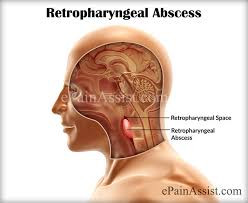Definition
A retropharyngeal abscess is an accumulation of pus in the retropharyngeal lymph nodes, located at the back of the throat near the cervical spine. This condition predominantly affects children aged 2-4 years, as the retropharyngeal lymph nodes typically begin to shrivel around age five. However, it can occasionally occur in older children and adults.
Although retropharyngeal abscesses are rare, they have the potential to be life-threatening.
Causes
In children under five, the retropharyngeal space comprises chains of lymph nodes that drain lymph fluid from the throat, tonsils, sinuses, and middle ear. Consequently, retropharyngeal abscesses in this age group usually result from the spread of infections within the respiratory tract, originating from the throat, sinuses, tonsils, or nose. A respiratory tract infection initially causes inflammation of the cervical lymph nodes, which may subsequently develop into a retropharyngeal abscess.
In contrast, retropharyngeal abscesses in older children and adults are more commonly attributed to trauma to the back wall of the throat, which allows bacterial invasion and abscess formation in the retropharyngeal space. Such injuries may occur due to medical procedures involving the mouth and throat or ingesting sharp foreign objects, such as fish bones. Approximately 25% of retropharyngeal abscess cases in this demographic result from trauma to the back wall of the throat.
Primary infections of the tonsils and teeth can also lead to retropharyngeal abscesses, although they more frequently cause peritonsillar and parapharyngeal abscesses. A rare but etiology is the direct spread of infection or inflammation from the spine.
Common pathogens responsible for retropharyngeal abscesses include Group A Streptococcus pyogenes, Staphylococcus aureus, Bacteroides, Fusobacterium, Haemophilus sp., and other respiratory tract organisms. Multiple bacteria could cause many infections. Additionally, HIV and TB are increasingly recognized as one cause of retropharyngeal abscesses. These organisms infect the lymph nodes in the posterior throat, leading to pus accumulation.
Risk factor
Several risk factors can increase the likelihood of developing a retropharyngeal abscess:
- Poor oral hygiene
- Diabetes mellitus
- Immunocompromised individuals, such as cancer patients, recipients of immunosuppressive drugs (e.g., steroids), individuals with HIV/AIDS, and post-organ transplant recipients
- Low socioeconomic status
Symptoms
In its early stages, retropharyngeal abscess may resemble a common sore throat. As the infection progresses, symptoms related to airway obstruction become more pronounced and generally worsen over time. Potential symptoms of retropharyngeal abscess that could occur include:
- Neck pain
- Painful or difficult swallowing
- Fever
- Neck stiffness
- Noisy or gasping breath sound
- Enlarged cervical lymph nodes
- Shortness of breath and rapid breathing
- Muffled voice
- Drooling due to inability to control saliva
- Difficulty or inability to open the mouth
- Chest pain (if the infection spreads to the chest cavity)
- The tendency to tilt the head or neck to one side or to lie down with the head tilted for easier breathing
Initially, there may only be mild to moderate inflammation and swelling in the throat, causing difficulty eating. As the condition advances, inflammation and swelling become more severe, eventually preventing the swallowing of saliva.
Diagnosis
A retropharyngeal abscess would be suspected when symptoms such as severe throat pain, neck stiffness, and noisy breathing follow a respiratory tract infection or throat injury. Laboratory tests, including a complete blood count and blood culture, may be conducted to detect infection. Definitive diagnosis requires imaging tests such as ultrasonography (USG), X-ray, or CT scan of the neck. Ultrasound and X-rays of the neck are preferred for children due to minimal radiation exposure from ultrasound and lower radiation exposure from X-rays. Meanwhile, a CT scan can provide detailed information about the location and extent of the abscess.
If symptoms include chest pain, a chest X-ray may be performed to determine whether the infection has spread to the chest cavity.
Management
All individuals diagnosed with retropharyngeal abscess must be hospitalized, treated with intravenous antibiotics, and referred to an otolaryngologist or an otolaryngologist-head and neck surgeon. Hospitalization is essential for close monitoring of airway safety, particularly during the first 24-48 hours after the initiation of therapy. In patients exhibiting symptoms of airway obstruction, immediate abscess drainage is necessary to alleviate the obstruction.
Treatment typically includes:
- Antibiotics. Broad-spectrum antibiotics, such as ceftriaxone, ampicillin-sulbactam, or clindamycin, are usually administered intravenously to combat a wide range of bacteria.
- Pus drainage. Surgical abscess drainage, often through an incision in the posterior pharyngeal wall, is performed to remove the pus.
- Intubation. Where the airway is obstructed, or during surgical drainage of the abscess, intubation (inserting a breathing tube) may be required.
Complications
Timely and precise treatment of retropharyngeal abscess typically yields favorable outcomes. However, improper management can lead to severe complications, including:
- Airway obstruction. As the abscess enlarges, it can increasingly block the airway, leading to airway obstruction and hypoxia. This is the primary cause of mortality in retropharyngeal abscess.
- The wide spread of infection into the bloodstream can cause septic shock and multiple organ failure.
- Bleeding of abscess.
- The abscess may rupture, causing pus to spread into the airway and potentially causing lung infections (pneumonia) or aspiration.
- Spread of infection to chest cavity. Infection can spread from the retropharyngeal space, which extends from the skull base to the posterior mediastinum, leading to serious chest cavity infections.
- Bronchial erosion.
- Erosion of the carotid blood vessels in the neck.
- Infection or blood clotting can occur in the neck jugular veins.
- Laryngeal spasms can result in respiratory distress.
- Cranial nerve damage.
- Infection of the meninges, the protective membranes covering the brain and spinal cord.
Prevention
Proper medical management of upper respiratory tract infections can prevent the development of retropharyngeal abscesses. Completing the full course of prescribed antibiotics is crucial to ensure complete eradication of the infection.
However, the use of antibiotics without a physician's supervision is not advised due to the risk of antibiotic resistance, which can complicate the treatment of future bacterial infections.
When to see a doctor?
Consultation with a healthcare provider is recommended if you or your child experiences throat pain accompanied by fever. Immediate medical attention is warranted if you experience symptoms such as:
- High fever
- Drooling (inability to swallow)
- Neck stiffness
- Difficulty breathing
- dr Anita Larasati Priyono
Retropharyngeal Abscess - Ear, Nose, and Throat Disorders - MSD Manual Consumer Version. MSD Manual Consumer Version. (2022). Retrieved 1 March 2022, from https://www.msdmanuals.com/home/ear,-nose,-and-throat-disorders/mouth-and-throat-disorders/retropharyngeal-abscess.
Jain, H., Knorr, T., & Sinha, V. (2022). Retropharyngeal Abscess. Ncbi.nlm.nih.gov. Retrieved 1 March 2022, from https://www.ncbi.nlm.nih.gov/books/NBK441873/.
Retropharyngeal Abscess: Practice Essentials, Pathophysiology, Epidemiology. Emedicine.medscape.com. (2022). Retrieved 1 March 2022, from https://emedicine.medscape.com/article/764421-overview#showall.
Retropharyngeal Abscess (for Parents) - Nemours KidsHealth. Kidshealth.org. (2022). Retrieved 1 March 2022, from https://kidshealth.org/en/parents/retropharyngeal-abscess.html.
Retropharyngeal Abscess: Practice Essentials, Pathophysiology, Epidemiology. Emedicine.medscape.com. (2022). Retrieved 1 March 2022, from https://emedicine.medscape.com/article/764421-overview#showall.











